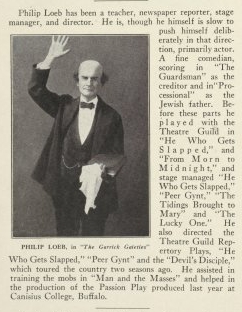
I return at last to “And Thereby Hangs a Tail,” a sketch based on the Scopes trial that appeared in The Garrick Gaieties, a revue that originally ran in 1925. (There were sequels of the same name in 1926 and in 1930.) The lyrics in the sketch are by Lorenz Hart (1895–1943), while the libretto is by Morrie Ryskind (1895–1985) and the revue’s director Philip Loeb (1891–1955). The sketch takes place in a courtroom in the jungle, where “[t]he defendant, Abbadaba Darwin, is charged with spreading the pernicious doctrine of evolution, which teaches that that stupid animal, man, is our grandchild.” William Jennings Bryan, played by Loeb (see above), is serving as the prosecutor. After he enters, singing a song praising his importance and betraying his avarice, he examines the defendant. Deciding, after a perfunctory questioning, that the defendant is unquestionably guilty as charged, Bryan turns to orate to the jury, composed of monkeys, about his respect and admiration for their kind.
Pausing for applause, Bryan is told by his brother Charlie that the cheers lasted for only six minutes. So he resumes his oration with a personal attack on the defendant, who is “not fit” (a joke here?) to be a monkey. Again he pauses for applause, plus a chorus of “Tammany”; Charlie reports that the cheers lasted for one hour and sixteen minutes, which apparently satisfies Bryan, who sits. The monkeys confer among themselves and then offer Bryan the nomination for President of the Jungle. Bryan accepts on condition that Charlie (who already ran for vice president of the United States in 1924) is nominated for vice president. There then ensues a further pause for applause, which Charlie reckons at eleven minutes: “Not bad for a vice-president.” Bryan accepts the nomination. The judge indicates that it’s necessary for monkey tails to be affixed to the candidates, but Bryan and Charlie turn their backs to the audience, whereupon their tails drop out of their pants. “We had them all the time,” they explain. Curtain.
As a commentary on the Scopes trial, “And Thereby Hangs a Tail” is negligible, but for understandable reasons. The first performance of The Garrick Gaieties (without the sketch) was on May 17, 1925. Bryan was already famous, or notorious, for his antievolution campaign, but he only agreed to join the prosecution on May 20, 1925. (True, the idea of his involvement was public earlier. The World’s Christian Fundamentals Association, which had recently endorsed Tennessee’s Butler Act, wrote to Bryan on May 13, 1925, to ask him to appear on its behalf at the trial. The Memphis Press then suggested that the prosecution team avail itself of Bryan’s assistance, and Sue Hicks—supposedly the original “Boy Named Sue” [PDF]—invited Bryan on board. His letter didn’t reach Bryan in Columbus, Ohio, where he was attending the Presbyterian General Assembly’s annual meeting, until May 20, 1925. Fresh from losing the post of vice-moderator in the assembly, Bryan immediately accepted the offer.)
The revised version of The Garrick Gaieties, including “And Thereby Hangs a Tail,” debuted on June 8, 1925, when the trial was still more than a month in the future—it began on July 10, 1925. So at least in their initial libretto, Ryskind and Loeb couldn’t have poked fun at the events in the Dayton, Tennessee, courtroom, and no doubt it would have been difficult to make substantive revisions to the libretto as the events unfolded. The trial received substantial coverage and commentary in the press, so Ryskind and Loeb could have taken a moment after the trial ended on July 21, 1925, to update the sketch. But after visits to Chattanooga and Winchester, Tennessee, Bryan returned on July 26, 1925, to Dayton, where he attended services at a Methodist church, ate a hearty lunch, took a nap, and died in his sleep. His death was headline news: The New York Times for July 28, 1925, devoted about a third of its front page, and all of its second page, to various stories about Bryan’s death and reviews of his career.
On page 13 of the same issue of the Times, however, under the headline “Revise Their Editions Because Bryan Died,” appeared a brief story noting that The New Yorker and Life were forced to revise issues of their magazines already in print because of the Great Commoner’s death. Moreover, “[a] scene in the Garrick Gaieties, in which Philip Loeb impersonated and lampooned Mr. Bryan, has been eliminated.” De mortuis nihil nisi bonum was the watchword. Except for the premise of a community of monkeys appalled at the suggestion of their genealogical connection with humans and the bit about the judge mistaking the black-skullcap-wearing Charlie Bryan for a rabbi, the only humor in “And Thereby Hangs a Tail” was from the constant jokes about Bryan’s pomposity, ambition, and avarice, and so the sketch was cut. Frankly, I doubt that it was a loss. Although Loeb may have put it across better on stage than it comes across on paper, the sketch struck me as generally predictable and uninspired.

